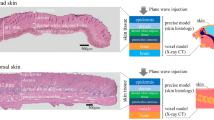Abstract
THE discovery1 that the temperature of skin overlying malignant tumours is frequently raised has led to an increasing medical interest in thermal patterns over the surface of the body. Attempts2,3 using infrared scanning devices (‘Aga’ scanner, Bofors Thermograph, and Pyroscan) have subsequently been made to identify pathology underlying the skin in terms of temperature differences at the surface. Thermal scanners measure the energy (Q) emitted by the surface. Consequently the patterns can reflect not only variations in temperature but also changes in emissivity (ε). Unfortunately, there is conflicting evidence on the magnitude of ε. Hardy and Muschenheim4 concluded that dead skin should be regarded as a black body (ε = 1). While this conclusion can be justified when Q is the total energy received at all wavelengths (λ) it is not necessarily applicable in the range 2µ < λ < 5.4µ over which the detectors used in these scanners are sensitive. More recent measurements5 show that the emissivity of post-mortem skin samples varies rapidly with λ. It is not clear, however, whether values of ε so obtained should be compared with values measured in vivo.
This is a preview of subscription content, access via your institution
Access options
Subscribe to this journal
Receive 51 print issues and online access
$199.00 per year
only $3.90 per issue
Buy this article
- Purchase on Springer Link
- Instant access to full article PDF
Prices may be subject to local taxes which are calculated during checkout
Similar content being viewed by others
References
Lawson, R. N., Canad. Med. Assoc. J., 75, 309 (1956).
Lloyd Williams, K., Ann. NY Acad. Sci., 121, 71 (1964).
Harris, D. L., Greening, W. P., and Archroth, P. M., Brit. J. Cancer, 20, 710 (1966).
Hardy, J. D., and Muschenheim, C., J. Clin. Invest., 13, 817 (1934).
Elam, R., Goodwin, D. W., and Lloyd Williams, K., Nature, 198, 1001 (1963).
Dreyfus, M. G., App. Optics, 2, 1113 (1963).
Maxwell Cade, C., Ann. NY Acad. Sci., 121, 71 (1964).
Jakob, M., Heat Transfer, 41 et seq. (Chapman and Hall, London, 1949).
Author information
Authors and Affiliations
Rights and permissions
About this article
Cite this article
WATMOUGH, D., OLIVER, R. Emissivity of Human Skin in vivo between 2.0µ and 5.4µ measured at Normal Incidence. Nature 218, 885–886 (1968). https://doi.org/10.1038/218885a0
Received:
Published:
Issue Date:
DOI: https://doi.org/10.1038/218885a0
This article is cited by
-
A century of exercise physiology: concepts that ignited the study of human thermoregulation. Part 4: evolution, thermal adaptation and unsupported theories of thermoregulation
European Journal of Applied Physiology (2024)
-
A century of exercise physiology: concepts that ignited the study of human thermoregulation. Part 2: physiological measurements
European Journal of Applied Physiology (2023)
-
A century of exercise physiology: concepts that ignited the study of human thermoregulation. Part 1: Foundational principles and theories of regulation
European Journal of Applied Physiology (2023)
-
Determining the thermal characteristics of breast cancer based on high-resolution infrared imaging, 3D breast scans, and magnetic resonance imaging
Scientific Reports (2020)
-
Variation of Effective Surface Emissivity with Angle and Implications for Clinical Thermography
Nature (1969)
Comments
By submitting a comment you agree to abide by our Terms and Community Guidelines. If you find something abusive or that does not comply with our terms or guidelines please flag it as inappropriate.



